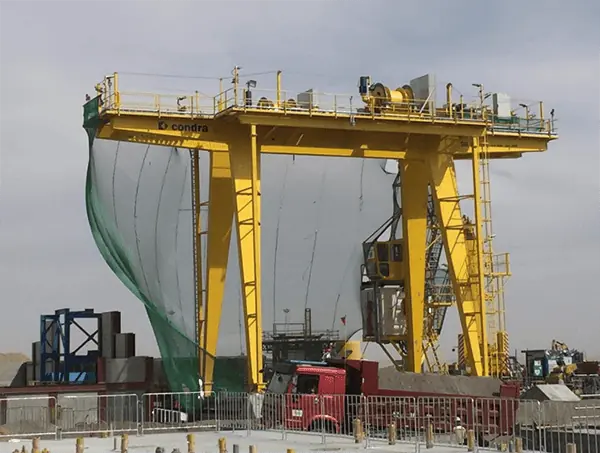CONDRA is to manufacture a high-lift, high-speed, heavy-duty kibble hoist of complex design as the key component of a 15-ton pre-sink portal crane.
Lifting height will be 150 metres – unusually high and needing careful calculation of drum dimensions and winding sequence. Kibble hoist capacity will be 10 tons less than two 25-ton pre-sink portal cranes previously manufactured as turnkey projects for mines in Asia and Africa, a consequence of smaller mineshaft diameters specified by the new customer.
The order for the kibble hoist points to Condra’s experience in specialised pre-sink cranes to its already widely accepted leadership in the high-lift arena.
In Africa, Condra has pioneered the concept and development of portal pre-sink design, the result being cranes that facilitate application of advanced mining techniques to dramatically fast-track the pre-sinking phase. Condra’s cranes have previously completed shaft pre-sinking to depths of 100 metres in just 120 days, work that usually takes up to eighteen months.
The pre-sink design combines rapid lifting speeds with optimised cross-travel via a crab-mounted hoist to transfer the loaded kibble to waiting dump trucks. Rails allow the portal frame to move aside from the shaft during blasting. This configuration is radically different from the level-luffing crane traditionally used for pre-sinking, where lifting speed is much lower and the crane’s jib is used to move the kibble to the trucks.
By contrast, Condra’s pre-sink portal uses a high-speed, high-lift main hoist to quickly remove excavated spoil vertically by means of the kibble through an opening in the centre of the drilling stage incorporated as an integral part of the crane. The crab-mounted hoist then moves horizontally to waiting dump trucks. Separate stage-winders mounted on the portal frame are used to position the drilling stage within the shaft.
The lifting speed of Condra’s latest kibble hoist will be a very fast 30m/min, or half a metre per second: almost ten times faster than hoist lifting speeds found in standard mine workshop applications.
The hoist will feature improved drives, gearboxes and safety devices, and enhanced operation by remote control.
Commenting on the new kibble hoist order, a Condra spokesman noted that the lifting height of 150 metres is just four metres short of the company’s high-lift record, held by an overhead crane servicing the Mohale Dam sluice gate. Lifting height there is 154 metres.
“The challenge of this particular design was not its lift height, which at 150 metres is in any case something noteworthy, but more in the calculations we had to carry out to perfect the design of the hoist drum,” the spokesman explained.
“Shaft diameters meant that a wide drum to accept simple storage of rope windings for a full lift of 150 metres was not possible.
“The shafts restrict lateral movement of the hoist ropes within them, so design had to coordinate drum width with a dimension that would precisely control and restrict lateral movement of the four ropes moving vertically. All four ropes have to remain within the shaft at any point of the kibble’s lift without fouling the sides,” elaborated the spokesman.
“So, the design process was complex because the 18-millimetre ropes wind onto or unwind from the drum in opposite directions as the drum rotates. At the same time, drum diameter had to be coordinated with motor design so that load placed on the electric motor will remain manageable throughout the non-stop nature of pre-sink work.”
The spokesman added that company management viewed the kibble-hoist order as confirmation of the market’s faith in Condra’s ability and willingness to customise high-lift hoist design to any specific requirement that a customer might have.
In central and southern Africa, Condra has for many years been widely acknowledged as the market leader in high-lift cranes, a reputation resting largely on the durability and reliability of the company’s K-Series hoist range.
Manufactured since 1972 and installed worldwide under a wide variety of operating conditions, Condra’s robust K-Series has proved particularly dependable under the conditions of increased mechanical strain associated with high lift.
K-Series hoists are produced in three main configurations: foot-mounted, monorail and double-rail crab. Lifting and reeving arrangements include centre-lift. Fully covered hoists provide lifting capacities to 32 tons, while open-drum units have capacities in excess of 250 tons.
Features on all models include electromagnetic DC disc brakes, standard frame-size motors with parallel rotors, double-acting limit switches, solid bronze rope guides and totally enclosed splash-lubricated gearboxes.
Visit Condra’s website for more information: www.condra.co.za
